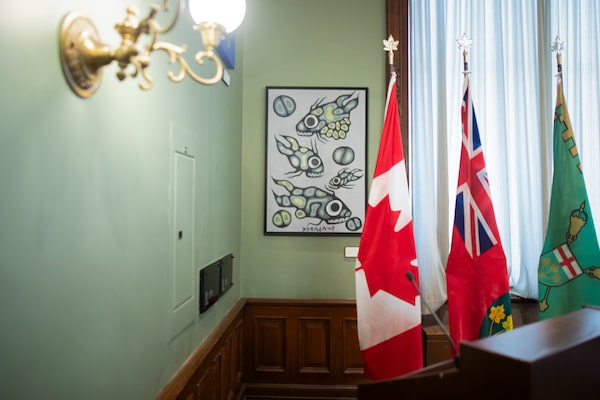
'Salmon Life Giving Spawn' a painting attributed to famous Indigenous artist Norval Morrisseau is photographed on Jan 22, 2024. The painting on exhibit at the Ontario Legislature, is believed to have characteristics that are in keeping with artwork seized by the Ontario Provincial Police as part of an art fraud investigation.Fred Lum/The Globe and Mail
At its heart, one of the world’s most audacious art frauds amounted to a paint-by-numbers operation, scarcely more sophisticated than a child’s colouring book.
Thunder Bay resident David Voss, aged 52, pleaded guilty on Tuesday to his central role in a multimillion-dollar counterfeiting ring that produced upwards of 1,500 works attributed to Norval Morrisseau, the international renowned Ojibwe painter.
A statement of facts read before Ontario Superior Court in Thunder Bay revealed the broad contours of the forgery ring for the first time since police made eight arrests in the case last March and labelled it the “biggest art fraud in world history” owing to the sheer number of counterfeited pieces involved.
Crown attorney John Corelli detailed how Mr. Voss sketched out drawings meant to mimic Mr. Morrisseau’s distinctive style and then annotated each section with letters indicating their ideal colour – ‘G’ for green, ‘B’ for blue, ‘LR’ for light red and so on. He would pass the sketches to hired painters to lay on the prescribed colours, before the works were signed with the Cree syllabic autograph Mr. Morrisseau was known for and backdated, usually to the 1970s.
It was a scheme arranged in an efficient assembly-line manner that netted millions of dollars between 1995 and the mid-2010s.
In court, Mr. Voss pleaded guilty to one count of forgery, for creating hundreds of fake paintings, and one count of uttering forged documents, relating to the fraudulent documentation he provided to authenticate the forgeries.
After the proceeding, a lead investigator in the case, Thunder Bay Police Detective Sergeant Jason Rybak, called Mr. Voss the “architect of this whole scheme.”
Once called Picasso of the North, Mr. Morrisseau died in 2007 having earned a reputation as one of the country’s greatest artists. His work featured X-ray depictions of people and animals outlined in thick black lines, a style that came to be called the Woodland School.
In the years before his death, Mr. Morrisseau identified dozens of counterfeit works. But buyers who tried to sue galleries for selling them suspect Morrisseaus ran into legal hurdles trying to prove a painting was a definitive fake. One plaintiff, Margaret Hatfield, a retired schoolteacher, bought Wheel of Life for $10,350 in 2005, and sued the seller in 2009. Two courts ruled against her, finding that the painting was a Morrisseau original.
Mr. Voss now admits it was a fake. Investigators submitted Wheel of Life to digital infrared photography at the Canadian Conservation Institute, which revealed Mr. Voss’s distinctive pencil outlines and letter codes beneath the overlying paint.
“I’d love to see Margaret’s face as she finds out that everything she argued, and that I argued on her behalf, has been confirmed,” said lawyer Jonathan Sommer, who argued Ms. Hatfield’s case and as well as a similar lawsuit brought by Barenaked Ladies member Kevin Hearn that was the subject of a documentary called There Are No Fakes. For years, Mr. Sommer tried in vain to get police to pursue the counterfeiting ring.
Police finally heeded those calls in 2020, when the Thunder Bay Police Service and the Ontario Provincial Police launched Project Totton.
Infrared photography provided the break they needed. Investigators analyzed 30 suspect paintings and found that 26 had the distinctive pencil marks underneath. An infrared analysis of authentic Morrisseaus found no such pencil marks.
Once he’d finished a canvas, Mr. Voss consigned or sold the fakes to distributors and auction houses. Randy Potter, who ran Kahn Country Auctions and Randy Potter Estate Auction in Port Hope, Ont., was the main destination, according to the agreed statement of fact read in court. Mr. Potter, who died in 2018, took a 30-per-cent commission for the 1,500 to 2,000 Voss-produced works he auctioned. He once testified in a civil case that average Morrisseaus fetched between $1,200 and $7,000, but some reached $30,000.
Mr. Voss told distributors that he’d acquired the works directly from Mr. Morrisseau and provided faulty documentation to authenticate the pieces.
In the Hatfield case, gallery owner Joseph McLeod testified that Mr. Voss’s father had acquired numerous Morrisseaus while working in a Kenora jail that incarcerated Mr. Morrisseau for a time. In reality, Mr. Voss’s father never worked in the jail and never “met, acquired artwork from, or otherwise interacted with” Mr. Morrisseau, according to the statement.
The statement mentions two Voss fakes that The Globe and Mail identified as suspected forgeries earlier this year.
In January, Salmon Life Giving Spawn was removed from a room at the Ontario Legislature and seized by police after a Globe story on the painting. The same month, the National Capital Commission announced it was working with police after The Globe identified Circle of Four as a suspected forgery.
Det. Sgt. Rybak said the painting was donated to the NCC collection by now-former senator Serge Joyal who acquired the piece at auction in the 1990s. He called both Mr. Joyal and the government of Canada victims of the Morrisseau art fraud.
Mr. Voss’s sentencing is scheduled for September.
Editor’s note: A previous version of this article included a photo with a caption that described a painting at McGill University as a “fake.” Questions have rather been raised about its authenticity. The photo has been replaced in this version of the article with a painting called 'Salmon Life Giving Spawn', which was previously displayed at the Ontario Legislature and determined to be a fake Norval Morrisseau painting in court Tuesday.